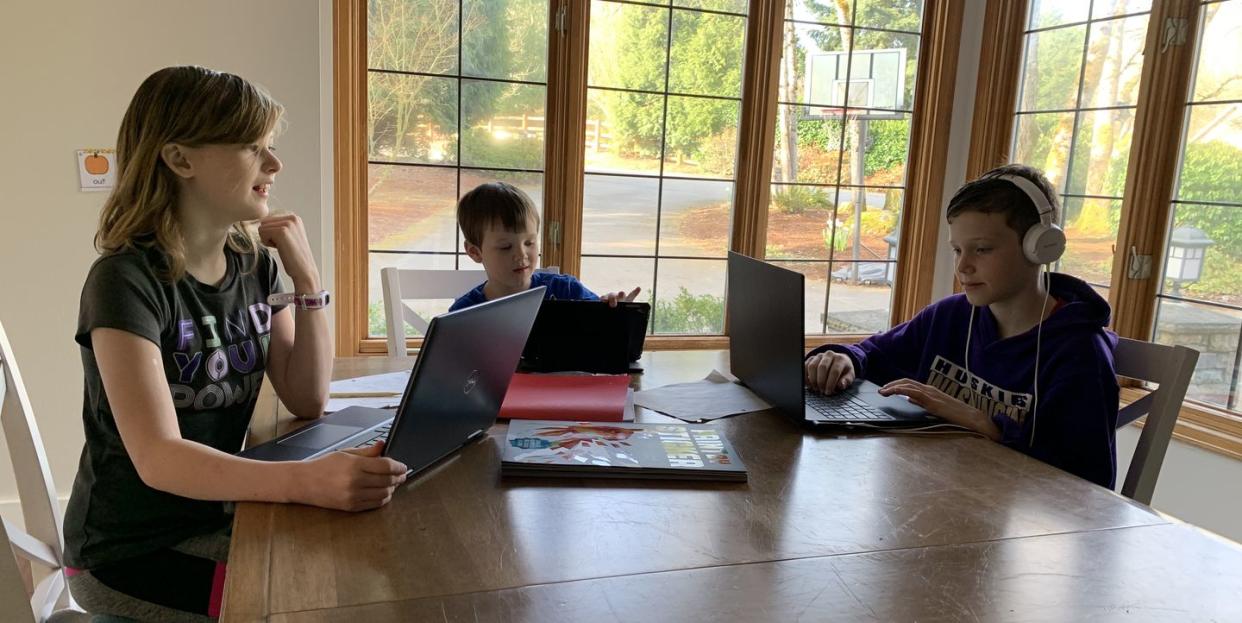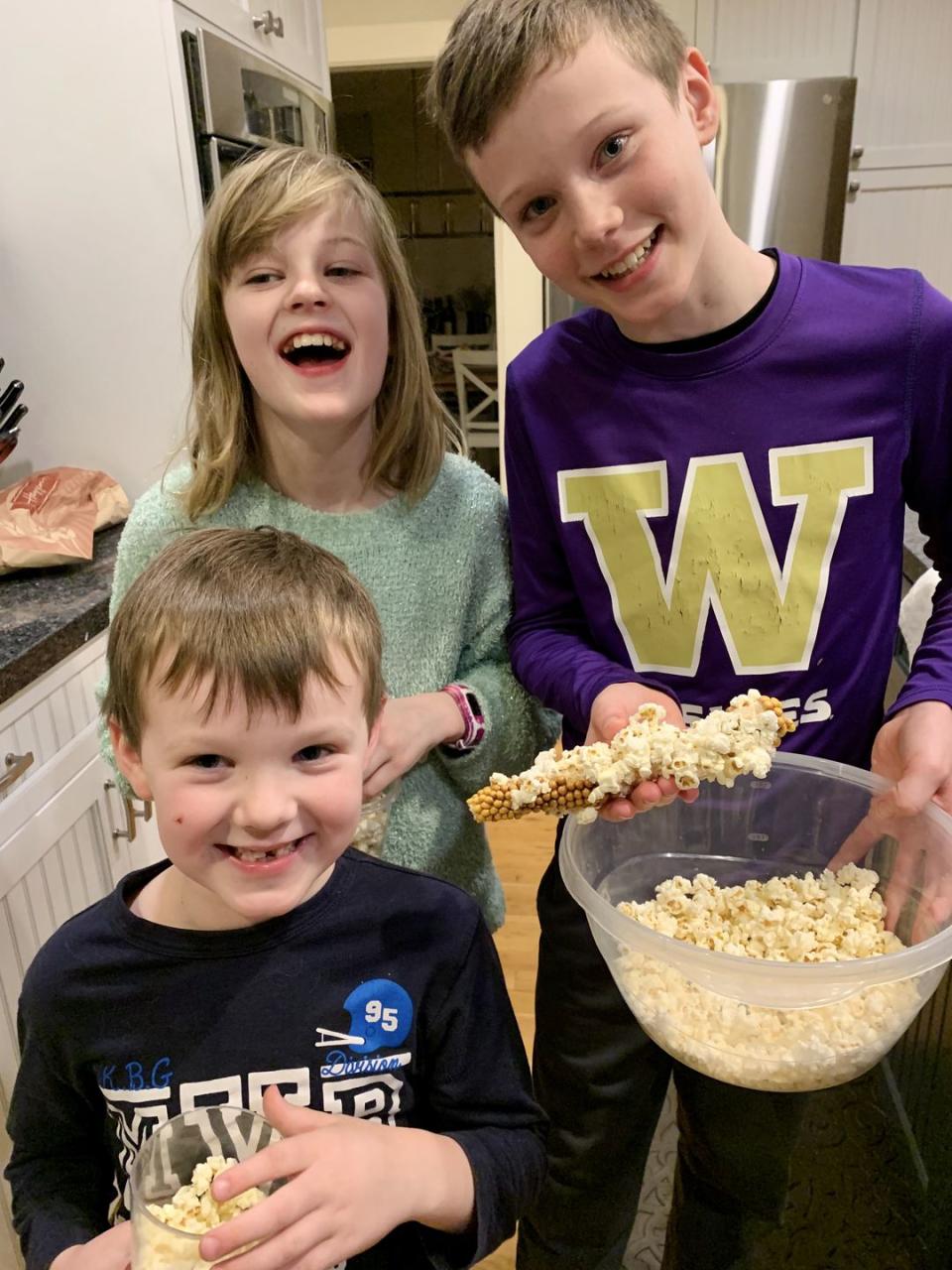'COVID-19 Closed My Kids' School 2 Weeks Ago. These 3 Rules Have Helped Us Survive.'

I live in Woodinville, Washington, just 5.6 miles from the Seattle-area nursing home that’s lost dozens of patients to COVID-19.
My kids' school district was among the first in the country to shutter when it sent students home indefinitely on March 5. Since then, many schools have followed suit, and still more will continue to close across the country in the coming days. The latest guidance from the CDC says school closures may need to last eight weeks or longer to make a positive impact in slowing the spread of the virus and, on Sunday, Ohio Gov. Mike DeWine said, “it would not surprise me at all if schools [in Ohio] did not open again this year.”
As a working mom who now finds herself also homeschooling a kindergartener, a third grader, and a fifth grader, it’s been a steep learning curve.
Desperately trying to make sense of the inscrutable way that kids are taught math while my oldest son grows more impatient by the minute is now a regular—and humbling—part of my day, as is searching for new tactics to keep my kindergartner focused and engaged.
Yesterday, his goal was to draw a character using geometric shapes and to write a three-sentence story. It took two tantrums and an hour and a half outside to finally get it done. I didn’t get the chance to work at all until 5:30 p.m., when my husband came home and was able to tag in for a couple hours.
Follow @modrentmessykid for much-needed laughs and inspiration!
A post shared by Mom Hacks I 🏆 Family Gear (@modrentmessykid) on Mar 18, 2020 at 3:36pm PDT
Nevertheless, we’re slowly finding our way. We’ve learned a lot in the past two weeks, and our new routines are taking shape.
If you’re just starting this journey, there are a few things I can recommend beyond the general wisdom touted in every “School’s Closed, Now What?” article flooding the web. Yes, be sure to get outdoor time, practice social distancing, make a schedule (you can see mine here), and above all else, wash your hands.
But while you’re doing all that, try the following three ideas, too. They’ll help ensure everyone feels like a contributing member of a team working towards a common goal—something that will become increasingly important to everyone’s sanity as the weeks unfold.
1. Start Having Weekly Family Meetings
Parenting experts regularly praise the positive effects of weekly family meetings, not the least of which include improved problem-solving and communication skills, as well as family cohesion. Right now, weekly meetings will also reinforce to your kids that you’re being thoughtful about how to keep them healthy and happy, instead of panicking about what’s happening in the news. By having a set time each week for everyone to pile on the couch, check in, and ask questions, you’re providing a much-needed sense of security.
It was at our first meeting that my husband and realized that our kindergartner had been quietly fretting for days that he’d fall behind once we started “doing school on computers” because he doesn’t yet know how to read.
Structure your meetings in a way that allows every family member time to talk about how they’re feeling, and make sure the kids are involved in any problem-solving to resolve issues. In our meetings, both my husband and I talk about what we think worked over the past week and what didn’t. The kids are given the opportunity to do the same, and then everyone brainstorms on how to improve in the week ahead.
It’s important not to go too long, especially if you have younger kids. Aim for 15 to 20 minutes, and always end with something fun. We often tack a movie night onto the end of our Sunday night family meeting so the kids see them as something to get excited about.

Finally, the first meeting is also a great time to create a family mission statement, to ask your kids if anything worries them about their school being closed, and to discuss if there are any big goals they want to set for this time at home. For more help, The Center for Parenting Education has lots of information on how to start your own weekly family meetings.
2. Get One-On-One Time With Each Child
Let’s not sugarcoat it; one of the toughest things about the coming weeks is going to be all that together time—especially for siblings. There will be blood. Okay, hopefully not, but there will be squabbles, and lots of them. One of the best things you can do to minimize these flare-ups is to focus on getting at least 10 minutes of one-on-one time a day with each child.
As adults, we don’t like to feel like we’re blending into a crowd. Our kids are no different. The more they feel seen and heard, the better they’ll do. Look for easy ways you can sneak in one-on-one time while you’re checking items off your to-do list. You can even have them hang out with you while you’re making dinner or folding laundry. It’s also okay to use screens to keep your other kid(s) busy so that you can focus on the activity of one child’s choosing. And there’s always the tried-and-true method of spending a few minutes in each kid’s room before bedtime.
At my house, I’ve started curling or braiding my daughter’s hair most mornings, even though that’s never been part of our morning routine and we won’t be leaving the house for anyone to see it. This gives us a few minutes together to check in, and I think she finds my focus, and my touch, a comforting way to start the day. I’m also routinely challenging my oldest son to one-on-one basketball in the driveway and letting my husband cook dinner while I snuggle on our bed and read to our youngest.
3. Reframe This Time As A Unique Opportunity
It’s important for our kids to continue reading, writing, and doing math every day to prevent educational back-sliding, but they can accomplish those tasks in so many interesting ways. Look at this as your chance to devote extra time to subjects your kids need more help with, or to topics schools don’t have time to cover due to rigid curriculums and standardized testing.
Since his routine was upended, my kindergartener has been struggling with more temper-tantrums than usual. Recently, I used Pinterest to gather a few age-appropriate worksheets and writing prompts that will help him learn about emotional regulation and anger management while also making art and working on phonics.
For my older kids, we’re using a free online program to help them become more financially literate. If nothing else, it’s a fascinating time to learn about the stock market, and they can use those studies to practice math and critical thinking skills, as well as to write research and opinion papers.

I’m letting my kids take the lead a lot, too. So far, they’ve shown an interest in improving their jump shots with Steph Curry’s 12-video masterclass and taking up American Sign Language. They’ve also asked to take on more responsibility cooking family dinners and managing their daily schedules.
This is an unprecedented time in our kids’ lives and will undeniably be memorable to them. There’s a lot we can’t control, but that doesn’t mean we’re powerless. Keep checking in with them, and don’t be afraid to attack problems in new ways. The terms "growth mindset" and "grit" have garnered an enormous amount of buzz in parenting communities in recent year; this may just be our opportunity to stop talking about those qualities and actually start fostering them.
Stephanie Morgan is the founder of Modern Parents Messy Kids. Follow her at @modrentmessykid.
You Might Also Like
